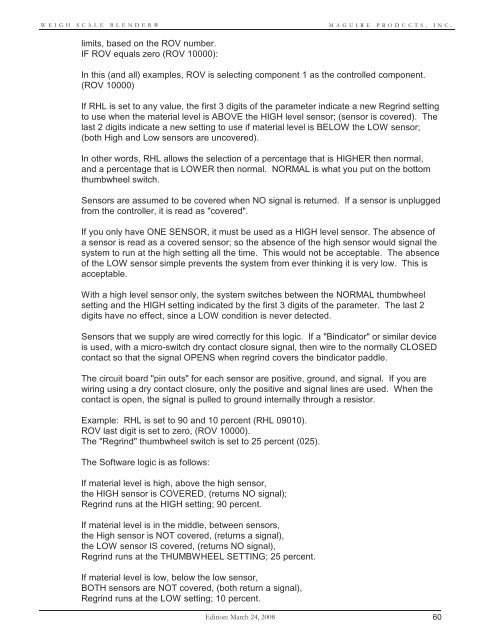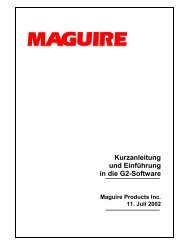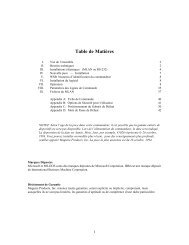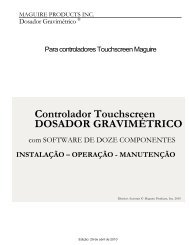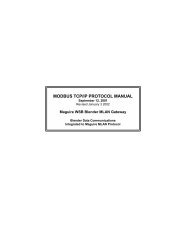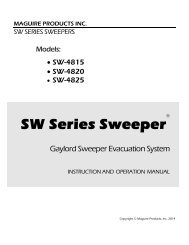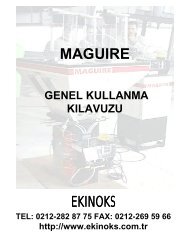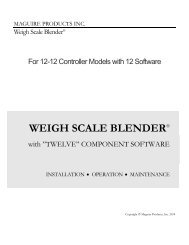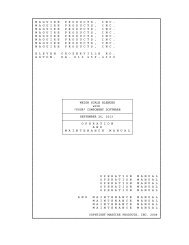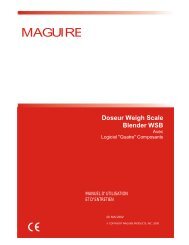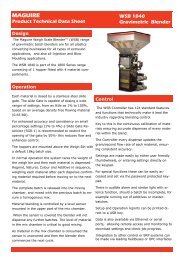WEIGH SCALE BLENDER® - Maguire Products
WEIGH SCALE BLENDER® - Maguire Products
WEIGH SCALE BLENDER® - Maguire Products
You also want an ePaper? Increase the reach of your titles
YUMPU automatically turns print PDFs into web optimized ePapers that Google loves.
<strong>WEIGH</strong> <strong>SCALE</strong> <strong>BLENDER®</strong><br />
MAGUIRE PRODUCTS, INC.<br />
limits, based on the ROV number.<br />
IF ROV equals zero (ROV 10000):<br />
In this (and all) examples, ROV is selecting component 1 as the controlled component.<br />
(ROV 10000)<br />
If RHL is set to any value, the first 3 digits of the parameter indicate a new Regrind setting<br />
to use when the material level is ABOVE the HIGH level sensor; (sensor is covered). The<br />
last 2 digits indicate a new setting to use if material level is BELOW the LOW sensor;<br />
(both High and Low sensors are uncovered).<br />
In other words, RHL allows the selection of a percentage that is HIGHER then normal,<br />
and a percentage that is LOWER then normal. NORMAL is what you put on the bottom<br />
thumbwheel switch.<br />
Sensors are assumed to be covered when NO signal is returned. If a sensor is unplugged<br />
from the controller, it is read as "covered".<br />
If you only have ONE SENSOR, it must be used as a HIGH level sensor. The absence of<br />
a sensor is read as a covered sensor; so the absence of the high sensor would signal the<br />
system to run at the high setting all the time. This would not be acceptable. The absence<br />
of the LOW sensor simple prevents the system from ever thinking it is very low. This is<br />
acceptable.<br />
With a high level sensor only, the system switches between the NORMAL thumbwheel<br />
setting and the HIGH setting indicated by the first 3 digits of the parameter. The last 2<br />
digits have no effect, since a LOW condition is never detected.<br />
Sensors that we supply are wired correctly for this logic. If a "Bindicator" or similar device<br />
is used, with a micro-switch dry contact closure signal, then wire to the normally CLOSED<br />
contact so that the signal OPENS when regrind covers the bindicator paddle.<br />
The circuit board "pin outs" for each sensor are positive, ground, and signal. If you are<br />
wiring using a dry contact closure, only the positive and signal lines are used. When the<br />
contact is open, the signal is pulled to ground internally through a resistor.<br />
Example: RHL is set to 90 and 10 percent (RHL 09010).<br />
ROV last digit is set to zero, (ROV 10000).<br />
The "Regrind" thumbwheel switch is set to 25 percent (025).<br />
The Software logic is as follows:<br />
If material level is high, above the high sensor,<br />
the HIGH sensor is COVERED, (returns NO signal);<br />
Regrind runs at the HIGH setting; 90 percent.<br />
If material level is in the middle, between sensors,<br />
the High sensor is NOT covered, (returns a signal),<br />
the LOW sensor IS covered, (returns NO signal),<br />
Regrind runs at the THUMBWHEEL SETTING; 25 percent.<br />
If material level is low, below the low sensor,<br />
BOTH sensors are NOT covered, (both return a signal),<br />
Regrind runs at the LOW setting; 10 percent.<br />
Edition: March 24, 2008 60


